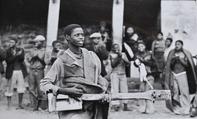‘Blik Kitaar’
The Ramkie guitar, also known as the ‘blik kitaar’, is an iconic, indigenous instrument pioneered by the Khoikhoi people during the 18th century. The Khoi-Khoi based their design of the ramkie guitar on that of a similar instrument brought to the Cape by Malabar slaves.

The early guitar was made from a gourd, a large fruit with a hard skin, and it has been theorized that it got its name from the Portuguese word ‘rabequinha’ - meaning ‘little violin’.
Although the ramkie guitar can be made from various materials, its base structure is the same throughout South Africa. The ‘modern’ version of the guitar is made from a hollowed oil can, or anything similar in weight and shape, with three to four strings made from fishing wire that is attached to a piece of wood. It is mostly used for chord-playing and not for melodic patterns.
Today, the ramkie guitar is a popular instrument that locals sell to tourists as memorabilia. They are often made from oil cans painted with the colours of the South African flag.